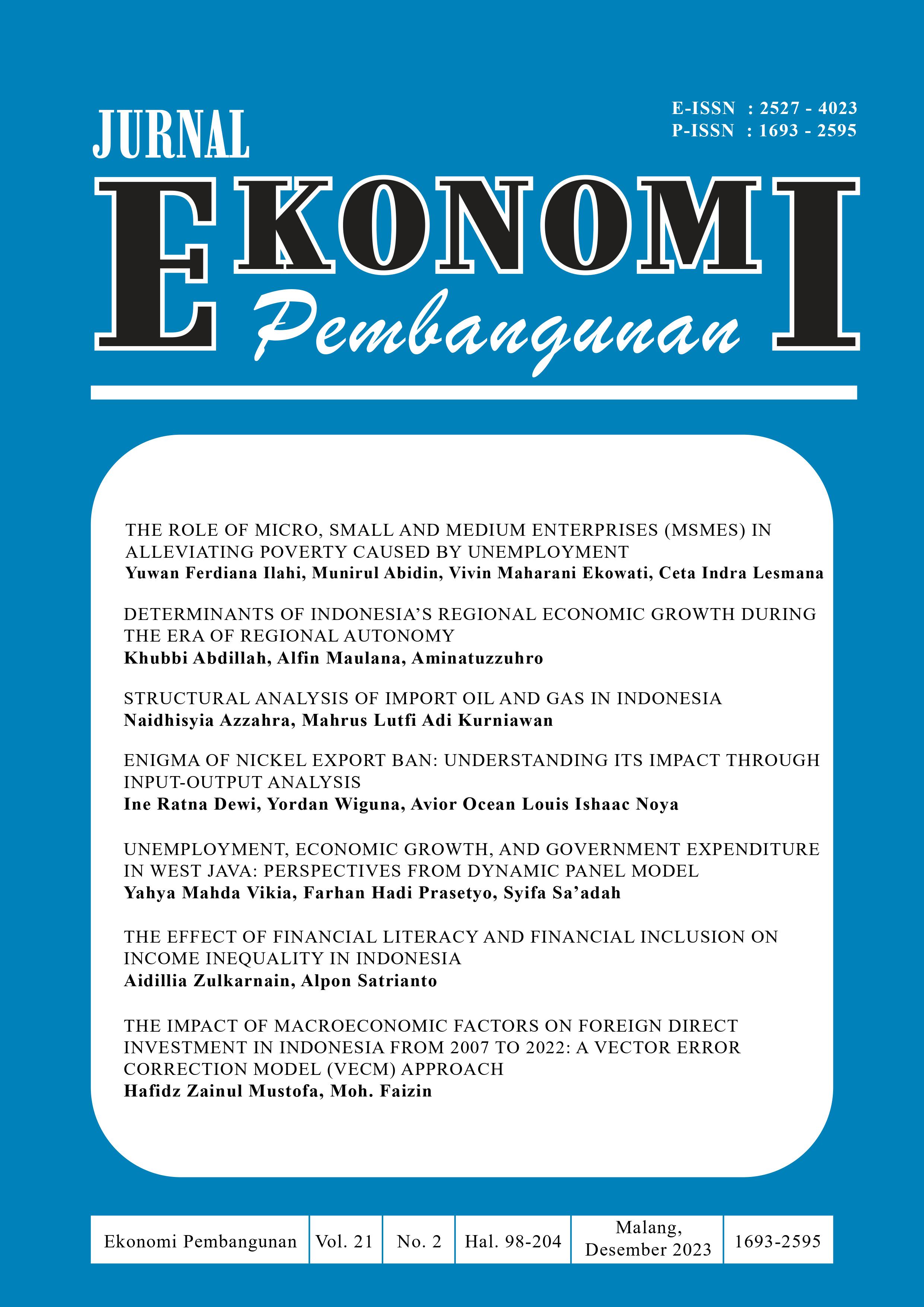The Effect of Financial Literacy and Financial Inclusion on Income Inequality in Indonesia
DOI:
https://doi.org/10.22219/jep.v21i02.29327Keywords:
Income Inequality, Financial Literacy, Financial Inclusion, poverty, wagesAbstract
Income inequality is an economic phenomenon that has an impact on economic instability and the welfare of society. Indonesia's income inequality has not significantly improved or changed much from previous years. This study aims to analyze the effect of financial literacy and financial inclusion on income inequality in Indonesia. The type of research used in this study is quantitative research. The data used is panel data of 34 provinces in Indonesia in 2016, 2019, and 2022. The analysis method used is Panel Data Regression using the Random Effect Model (REM) approach. The results show that (1) financial literacy does not affect income inequality in Indonesia; (2) financial inclusion does not affect income inequality in Indonesia; (3) poverty has a significant positive effect on income inequality in Indonesia; and (4) wages has a significant negative effect on income inequality in Indonesia. Suggestions in this study: Financial institutions should start expanding the target of introducing new and existing products to increase public understanding and confidence, especially among the lower middle class. In addition, government intervention must be carried out massively and aggressively so that a general understanding of finance increases.
Downloads
References
Apergis, N., Dincer, O., & Payne, J. E. (2011). On the dynamics of poverty and income inequality in US states. Journal of Economic Studies, 38(2), 132–143. https://doi.org/10.1108/01443581111128370
Badan, P. S. (n.d.). Gini Ratio Menurut Provinsi dan Daerah 2022-2023. Badan Pusat Statistik. https://www.bps.go.id/indicator/23/98/1/gini-rasio.html
Batsaikhan, U. (2018). Financial literacy and inclusive growth in the European Union. Bruegel Policy Contribution Issue n˚ 08| May 2018.
Buhaerah, P. (2017). Pengaruh Finansialisasi Terhadap Ketimpangan Pendapatan Di Asean : Analisis Data Panel. Buletin Ekonomi Moneter Dan Perbankan, 19(3), 335–352.
Bustami, K., & Saifrizal, M. (2022). Financial Literacy Capabilities in Increasing Financial Inclusion Through Sharia Fintech. Jurnal Ekonomi, 11(03), 1073–1081. http://ejournal.seaninstitute.or.id/index.php/Ekonomi/article/view/832
Chancel, L., Piketty, T., Saez, E., & Zucman, G. (2022). WORLD.
Egawa, A. (2013). Bruegel Working Paper 2013 / 06 Will Income Inequality Cause a Middle-Income Trap in Asia ? Bruegel Working Paper, 06(October).
Ghozali, I. (2018). Aplikasi analisis multivariate dengan program IBM SPSS 25 edisi ke-9. Badan Penerbit Universitas Diponegoro. https://onesearch.id/Record/IOS2851.slims-19545
Hassan, S. A., Zaman, K., & Gul, S. (2015). The Relationship between Growth-Inequality-Poverty Triangle and Environmental Degradation: Unveiling the Reality. Arab Economic and Business Journal, 10(1), 57–71. https://doi.org/10.1016/j.aebj.2014.05.007
Hoch, I. N. (2013). Can Financial Literacy Help Alleviate Wealth And Income Inequality In The US ? 18(1), 2013.
Lin, C., & Yun, M. S. (2016). The effects of the minimum wage on earnings inequality: Evidence from China. Research in Labor Economics, 44, 179–212. https://doi.org/10.1108/S0147-912120160000044012
Litwin, B. S. (2015). Determining the Effect of the Minimum Wage on Income Inequality. Student Publications, 300, 1–22. https://cupola.gettysburg.edu/student_scholarshiphttps://cupola.gettysburg.edu/student_scholarship/300https://cupola.gettysburg.edu/student_scholarship/300
Lo Prete, A. (2013). Economic literacy, inequality, and financial development. Economics Letters, 118(1), 74–76. https://doi.org/10.1016/j.econlet.2012.09.029
Lusardi, A., & Mitchell, O. S. (2012). Financial Literacy Around the World: An Overview. SSRN Electronic Journal, June. https://doi.org/10.2139/ssrn.1810551
Muslikhah, A. S., & Utami, E. D. (2020). Pengaruh Inklusi Keuangan Terhadap Ketimpangan Pendapatan Di Indonesia Tahun 2012-2017. Seminar Nasional Official Statistics, 2019(1), 738–748. https://doi.org/10.34123/semnasoffstat.v2019i1.102
Omar, M. A., & Inaba, K. (2020). Does financial inclusion reduce poverty and income inequality in developing countries? A panel data analysis. Journal of Economic Structures, 9(1). https://doi.org/10.1186/s40008-020-00214-4
Otoritas Jasa Keuangan. (2017). Statistik Perbankan Indonesia 2017. Statistik Perbankan Indonesia 2017, 16, No. 1, 195.
Rozali, M. (2020). Faktor Faktor yang Mempengaruhi Ketimpangan Distribusi Pendapatan dan Implikasinya terhadap Kemiskinan di Propinsi Sumatera Selatan. Jurnal Ekonomi, 22(1), 1–16.
Wibowo, T. (2016). Ketimpangan Pendapatan dan Middle Income Trap Income Inequality and Middle Income Trap. Kajian Ekonomi Keuangan, 20(2), 111–132. http://fiskal.kemenkeu.go.id/ejournal
Downloads
Published
Issue
Section
License
Copyright (c) 2024 Aidillia Zulkarnain, Alpon Satrianto

This work is licensed under a Creative Commons Attribution-NonCommercial-ShareAlike 4.0 International License.
Authors who publish with Jurnal Ekonomi Pembangunan (JEP) agree to the following terms:
- For all articles published in Jurnal Ekonomi Pembangunan (JEP), copyright is retained by the authors. Authors permit the publisher to announce the work with conditions. When the manuscript is accepted for publication, the authors agree to the publishing right's automatic transfer to the publisher.
- Authors retain copyright and grant the journal right of first publication with the work simultaneously licensed under a Creative Commons Attribution-NonCommercial-ShareAlike 4.0 International License that allows others to share the work with an acknowledgment of the work's authorship and initial publication in this journal.
- Authors can enter into separate, additional contractual arrangements for the non-exclusive distribution of the journal's published version of the work (e.g., post it to an institutional repository or publish it in a book), with an acknowledgment of its initial publication in this journal.
- Authors are permitted and encouraged to post their work online (e.g., in institutional repositories or on their website) before and during the submission process, as it can lead to productive exchanges and earlier and greater citation of published work (See The Effect of Open Access).

This work is licensed under a Creative Commons Attribution-NonCommercial-ShareAlike 4.0 International License.






















